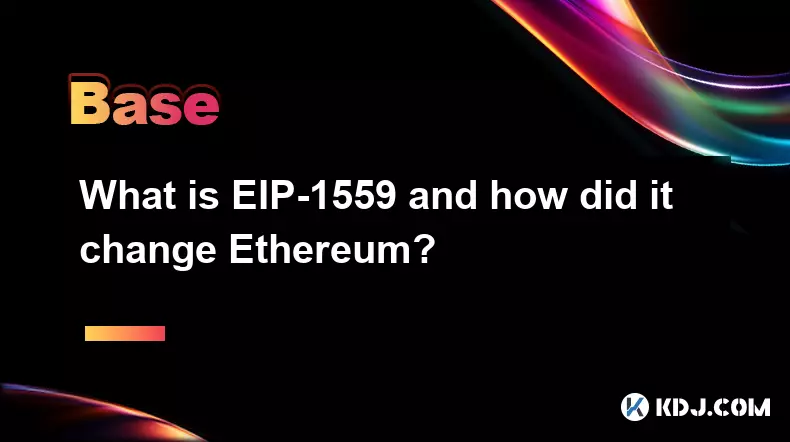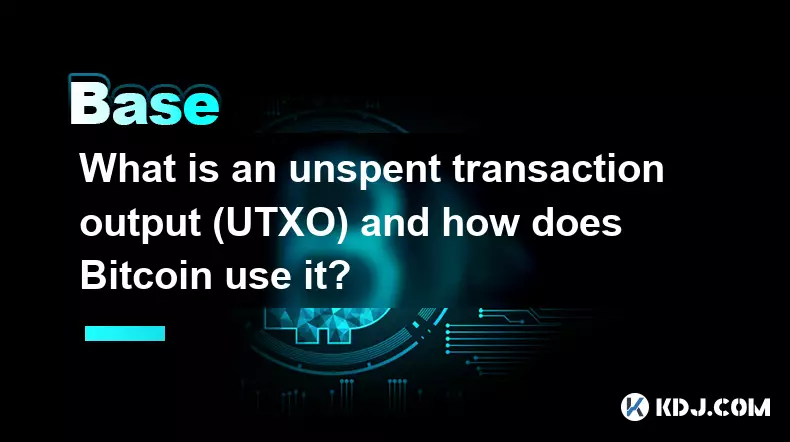-
 bitcoin
bitcoin $95122.959084 USD
-0.06% -
 ethereum
ethereum $3142.532402 USD
-0.28% -
 tether
tether $0.999439 USD
0.01% -
 xrp
xrp $2.209207 USD
-2.80% -
 bnb
bnb $925.395975 USD
0.07% -
 solana
solana $138.662599 USD
-1.73% -
 usd-coin
usd-coin $0.999753 USD
-0.02% -
 tron
tron $0.294100 USD
0.03% -
 dogecoin
dogecoin $0.161321 USD
0.35% -
 cardano
cardano $0.498672 USD
-1.53% -
 hyperliquid
hyperliquid $38.406659 USD
1.34% -
 zcash
zcash $679.663571 USD
5.44% -
 bitcoin-cash
bitcoin-cash $501.381807 USD
3.53% -
 chainlink
chainlink $13.975571 USD
-0.64% -
 unus-sed-leo
unus-sed-leo $9.166130 USD
-0.37%
What is EIP-1559 and how did it change Ethereum?
EIP-1559 introduced a dynamic base fee that’s burned, reducing ETH supply and making transaction costs more predictable.
Sep 02, 2025 at 03:00 pm

Understanding EIP-1559 and Its Core Mechanism
1. EIP-1559 is a protocol upgrade introduced to the Ethereum blockchain in August 2021 as part of the London hard fork. It redefined how transaction fees are processed and distributed across the network. Unlike the previous auction-based model where users bid on gas prices, EIP-1559 introduced a dynamic base fee that adjusts based on network congestion.
2. The base fee is algorithmically determined and burned, meaning it is permanently removed from circulation. This mechanism ensures that the fee reflects real-time demand for block space. Users can still include a priority fee, also known as a tip, to incentivize miners to include their transactions faster.
3. By establishing a predictable pricing model, EIP-1559 reduced the volatility of transaction costs. Users no longer need to overpay drastically during peak times, as the system automatically scales the base fee up or down depending on block usage.
4. The inclusion of fee burning introduced a deflationary pressure on the ETH supply. When network activity is high, large amounts of ETH are burned, occasionally leading to net-negative issuance on certain days.
5. This shift altered the economic behavior of participants. Wallets and decentralized applications began integrating EIP-1559-aware transaction estimators, improving user experience by providing clearer fee forecasts.
Impact on Ethereum’s Monetary Policy
1. Prior to EIP-1559, all transaction fees were awarded to miners, contributing to ETH inflation. With the burning mechanism, a significant portion of fees now exits the circulating supply, transforming ETH into a partially deflationary asset under certain conditions.
2. The deflationary effect became particularly visible during periods of high network utilization, such as NFT mints or DeFi surges, where daily ETH burns exceeded new issuance. This dynamic strengthened the narrative of ETH as a digital asset with intrinsic value accrual mechanisms.
3. The change also influenced staking economics post-Merge. Validators receive tips and block rewards, but the base fee burn reduces the total revenue flowing into the ecosystem, altering long-term incentive structures.
4. Market participants began analyzing “net issuance” as a key metric, comparing daily ETH issuance against burn rates. This data is now widely tracked on block explorers and on-chain analytics platforms.
5. Some critics argue that fee burning benefits holders at the expense of users, especially during congestion. However, proponents maintain that the predictability and efficiency gains outweigh these concerns.
Effects on User Experience and Network Efficiency
1. One of the most immediate benefits of EIP-1559 was the improvement in transaction predictability. Users can now estimate fees with greater accuracy, reducing the likelihood of overpayment or delayed confirmations.
2. Wallet interfaces adapted to display base fees and tips separately, giving users granular control over their transaction costs. This transparency empowered non-technical users to make informed decisions without relying on complex gas optimization strategies.
3. The upgrade also laid the groundwork for future scalability solutions. By decoupling fee pricing from miner incentives, EIP-1559 made it easier to implement layer-2 fee markets and account abstraction initiatives.
4. During high-demand events, the base fee adjusts within minutes, smoothing out transaction backlogs more efficiently than the old first-price auction model. This responsiveness reduced the frequency of network gridlock.
5. Developers began designing dApps that react to fee levels, such as delaying non-urgent operations when base fees exceed thresholds. This adaptive behavior contributes to more resilient decentralized systems.
Frequently Asked Questions
What happens to the ETH that is burned under EIP-1559?The ETH burned through the base fee is permanently removed from the circulating supply. It is sent to a burn address, making it irrecoverable. This reduces the total amount of ETH in circulation over time.
Do miners still earn transaction fees after EIP-1559?Miners, and later validators after the Merge, receive the priority fee (tip) and the block reward. The base fee portion is burned and does not go to any participant, effectively redistributing value to ETH holders through supply contraction.
Can the base fee drop to zero?The base fee cannot drop to zero. It adjusts based on block utilization, decreasing when blocks are underfilled but always remaining above zero to maintain market responsiveness and prevent spam transactions.
How does EIP-1559 affect gas price volatility?It significantly reduces short-term volatility by smoothing fee adjustments across blocks. Instead of sudden spikes due to bidding wars, the base fee changes incrementally, providing a more stable and predictable cost environment.
Disclaimer:info@kdj.com
The information provided is not trading advice. kdj.com does not assume any responsibility for any investments made based on the information provided in this article. Cryptocurrencies are highly volatile and it is highly recommended that you invest with caution after thorough research!
If you believe that the content used on this website infringes your copyright, please contact us immediately (info@kdj.com) and we will delete it promptly.
- $EVA Token, Airdrop, Powday Farm: What's the Buzz in the Metaverse?
- 2025-11-17 02:50:02
- BTC Amsterdam 2025 & Stablecoin Growth: A Bullish Outlook?
- 2025-11-17 02:45:01
- December Rate Cut Odds: A NYC Perspective on the Fed's Next Move
- 2025-11-17 02:45:01
- Xenea Wallet Daily Quiz: Your Fast Track to Earning Crypto
- 2025-11-17 02:40:02
- Web3 Gaming Economies: Bridging Liquidity Gaps with Innovation
- 2025-11-17 02:40:02
- Zero Knowledge Proof, Crypto Presales, and No KYC: A New Era of Inclusive Finance
- 2025-11-17 00:10:01
Related knowledge

What is the difference between a transparent and a shielded transaction?
Nov 10,2025 at 05:59pm
Understanding Transparent Transactions in Cryptocurrency1. Transparent transactions are the standard form of transaction on most public blockchains li...

What is a "crypto airdrop farmer" and what strategies do they use?
Nov 09,2025 at 03:39pm
What Is a Crypto Airdrop Farmer?1. A crypto airdrop farmer is an individual who actively participates in blockchain projects to qualify for free token...

What is an unspent transaction output (UTXO) and how does Bitcoin use it?
Nov 12,2025 at 01:40am
Understanding the Concept of Unspent Transaction Output (UTXO)1. An Unspent Transaction Output, commonly referred to as UTXO, is a fundamental compone...

What is a "governance attack" and how can a DAO be compromised?
Nov 14,2025 at 05:59am
Understanding Governance Attacks in Decentralized Autonomous Organizations1. A governance attack occurs when an individual or group gains disproportio...

How do you track a crypto portfolio across multiple wallets and chains?
Nov 12,2025 at 04:19pm
The Evolution of Decentralized Exchanges in the Crypto Ecosystem1. Decentralized exchanges (DEXs) have transformed how users trade digital assets by r...

What is a "rug pull" clause in a smart contract and how can you spot it?
Nov 14,2025 at 11:40pm
Understanding the Concept of a Rug Pull in Decentralized Finance1. A rug pull refers to a malicious act in the cryptocurrency space where developers a...

What is the difference between a transparent and a shielded transaction?
Nov 10,2025 at 05:59pm
Understanding Transparent Transactions in Cryptocurrency1. Transparent transactions are the standard form of transaction on most public blockchains li...

What is a "crypto airdrop farmer" and what strategies do they use?
Nov 09,2025 at 03:39pm
What Is a Crypto Airdrop Farmer?1. A crypto airdrop farmer is an individual who actively participates in blockchain projects to qualify for free token...

What is an unspent transaction output (UTXO) and how does Bitcoin use it?
Nov 12,2025 at 01:40am
Understanding the Concept of Unspent Transaction Output (UTXO)1. An Unspent Transaction Output, commonly referred to as UTXO, is a fundamental compone...

What is a "governance attack" and how can a DAO be compromised?
Nov 14,2025 at 05:59am
Understanding Governance Attacks in Decentralized Autonomous Organizations1. A governance attack occurs when an individual or group gains disproportio...

How do you track a crypto portfolio across multiple wallets and chains?
Nov 12,2025 at 04:19pm
The Evolution of Decentralized Exchanges in the Crypto Ecosystem1. Decentralized exchanges (DEXs) have transformed how users trade digital assets by r...

What is a "rug pull" clause in a smart contract and how can you spot it?
Nov 14,2025 at 11:40pm
Understanding the Concept of a Rug Pull in Decentralized Finance1. A rug pull refers to a malicious act in the cryptocurrency space where developers a...
See all articles

























![Coin Master Hack Spins 2025 ✅ Coin Master Free Spins[ Android _ iOS ] [LINK IN COMMENT] Coin Master Hack Spins 2025 ✅ Coin Master Free Spins[ Android _ iOS ] [LINK IN COMMENT]](/uploads/2025/11/16/cryptocurrencies-news/videos/6919c627821e7_image_120_90.webp)
















































